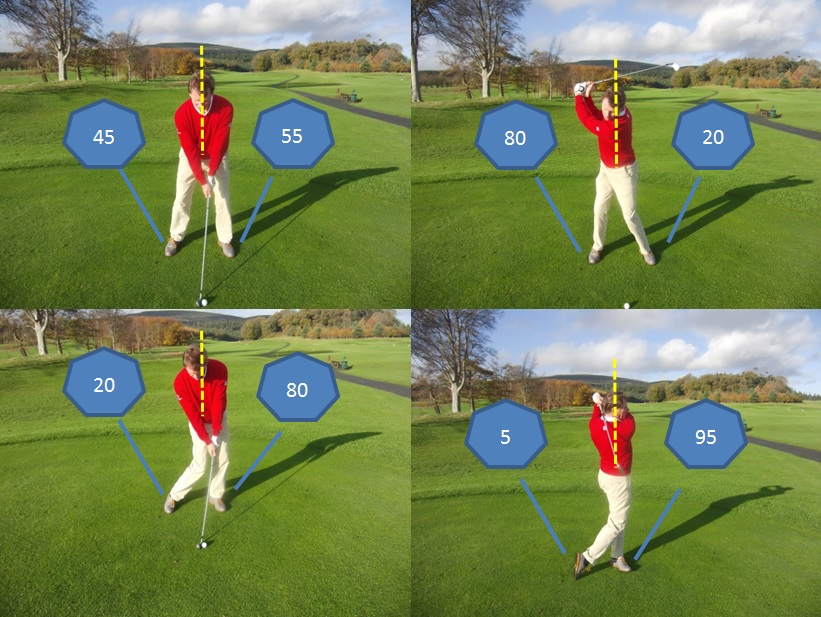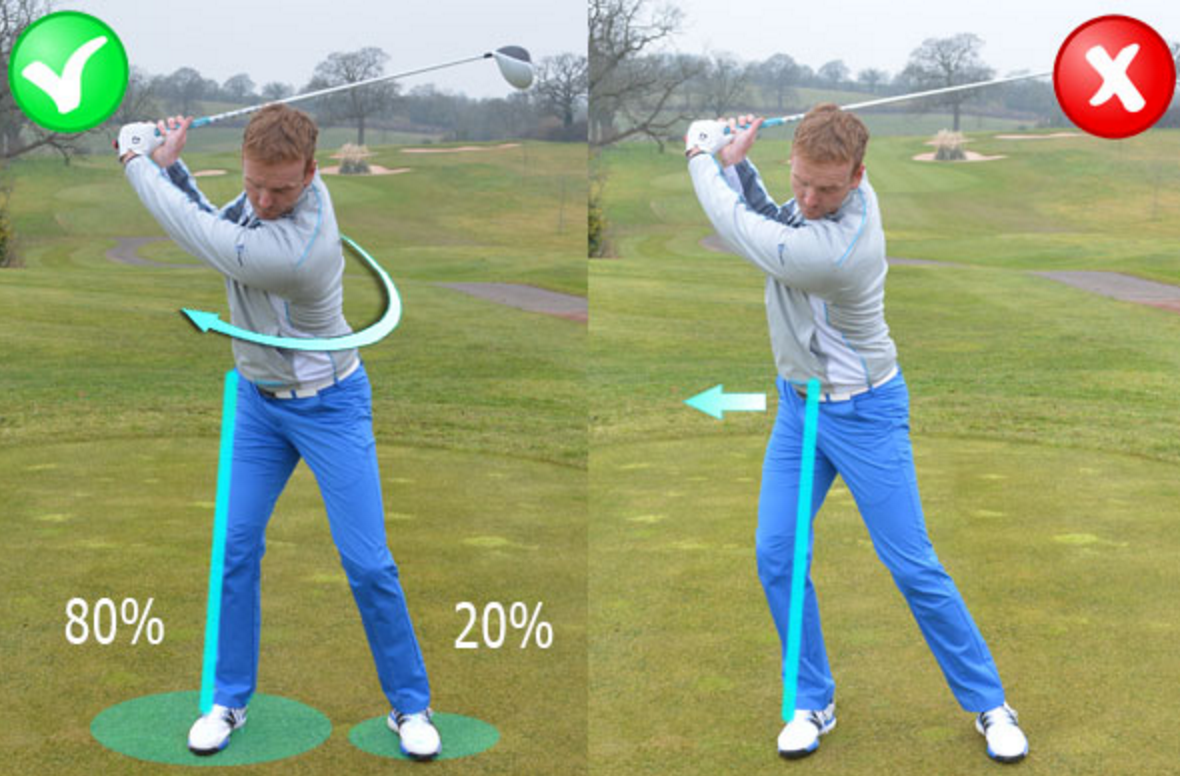In this video I talk about the golf swing weight shift. The legs are the motor to your swing so learning the proper weight shift is vital if you want to create power.
You create power by loading the weight then shifting it between the 2 feet. Along with this shift is the rotation of your body. The faster you can shift the faster your body will rotate. Now, connected to this rotation is the hinging and re-hinging of your wrists. A lot of people seem to think that the power solely comes from this wrist action. What they are missing is that this wrist action has to be connected to something. That something is the rotation of the body from your waist up. The weight shift between your 2 feet helps to speed up this rotation. This is not to say you can’t hit good shots without using your feet. You can hit them better if you do use your feet and this shift between them.
Weight moving left during the takeaway. Many golf teachers will refer to this mistake as a 'reverse pivot', and it is one of the most damaging things that you can do to your golf swing. As the club starts to move away from the ball during the takeaway, your weight will begin to shift to the left. In that processthe weight will shift through impact, will be upwards for 70 percent at the moment we’re hitting the ball. If not more than that, and then from there the club will go, continue on, our weight will move to 90 percent, and 10 percent on the back leg. A good rule of thumb is to set up with the golf ball inside your left ear (right hander). This is the right position to guarantee a good transfer of weight from start to finish. Next, you need to ensure you have a small amount of axis tilt where your lead shoulder is a fraction higher at set up than the rear shoulder. A lot of golf teachers have talked about weight shift or said something like “get your weight on your back foot, in the backswing”. We have always used that term weight but biomechanically that is not the correct term. Weight is basically your body segments and so your form has a mass to it and where your weight is your body segments are. Get to the left heel: Your weight should shift to your left toes and then into your left heel. If you really want to develop power, you need to transfer your weight properly.
Make sure you watch this tip and start to incorporate the loading into the back foot and the shifting/turning into the forward foot. It takes a little time but if you keep that it will certainly see a huge increase in your power if you keep doing it.
Transcription – Golf Swing Weight Shift

In this tip I want to talk about the weight shift throughout our whole golf swing.
First of, we want to look at our address position, then we want to look at the top of the backswing, impact and then our follow through position. So, let’s start with our setup position. As far as our setup is concerned, we want our weight 50:50 between the feet, and yes I know there’s people that want you to favor your right side when you do your address position. I don’t want you to do that. Because we don’t want to hit the golf ball going back. So, I want you at 50:50. If you favor this side, you’re presetting your whole body on a tilt, which is going to make you tilt too much as you come through the shot. So, we’re going to start 50:50. we’re going to get this tilt by unwinding properly with our lower body. So, I don’t need you to pre-tilt in the beginning. So, we’re going to be at 50:50 as far as left and right is concerned. Now, take a look at the toes vs. the heels. You want your weight in the middle of your feet, so to get that you can just rock back and forth, if you rock back and forth a little bit, you’ll feel where your laces are. That’s where we want to be balanced with our feet. Now, we also have to take a look at inside or outside of our feet. So, here, if you’ve got your knees knocked in, you’re going to feel the way on the instep, and if you’ve got your knees turned out, you’re going to feel it on the outside of your feet.
So, we want our knees basically straight ahead, but not knocked in. so, in that position we’re going to feel our feet leveled to the ground, or planted level as we do our setup. So, we don’t want to be on the inside or the outside of our feet. We want the soles of our shoes flush on the ground at 50:50. OK. Now, as we go into the top of the backswing position. From 50:50 I’m going to move to 80, and then 20. 80, 20. Now, the weight distribution itself will going to be on the instep heel area of this back foot. Now, a good way to feel that is to just pick up a ball like this, and make a throwing motion with the ball. So, I guarantee you, if you go to through this ball, you’re going to feel the weight on the instep heel of that back foot. See, we already know how to do these moves, it’s just in golf the ball is stationary, so we have to tell ourselves to do it. We’ve already done this a million times before. So, if you’ve ever thrown the ball, you have loaded into this back foot, and then you’ve used that to make the throwing motion. So, this is the same place we want to go to, when we’re in our golf swing. So, try throwing the ball, and that will give you the feeling of where the weight is, and it’s on the instep heel, at about 80 percent. So, if I go like this, I go into the backswing, OK, I feel the weight right now, 80 percent on the instep heel. A good way to get that is to just take the club to the top like this, and you can bounce a little bit on this leg. If you bounce a little bit, then you’ll feel the weight on that side. So, that’s where we try to get that balance point. You’re trying to memorized this spot at a very top of your swing, so that you feel the weight over here. We definitely don’t want a weight on our left at the top of our backswing. Because if we do, our whole body will be tilted to the left, and that’s going to spell disaster. You’re going to hit the ball, you’re going to come over the top, you’re going to hit pulls, and even slices from there. So, we want the weight going over to this back leg, and we want it 80 percent.
Left Heel Golf

Now, as the club comes down towards impact, what we’re trying to do here is, from the right of this moment in time, we’re going to be gradually shifting our weight, so from here it’s 80 percent, it’s 70 percent, it’s 60 percent, then it switches to 70, minimum with 70, 30, as you’re hitting the golf ball. So, what I don’t want you to do is to go up at the top like this, and then shift. We don’t want to be shifting up here, we want to be turning, because we’re going to be trying to take this leg, and we’re going to try and touch the other leg, to get into our finish position. And I cover that in a previous lesson. So, if I go from here, and I try to take this leg and touch that leg, my weight has to shift because I can’t get to this position with my feet flat on the ground. If I’m here, my weight just shifted, and I didn’t even think about shifting it. So, I thought about turning, by taking this leg and trying to touch the other leg. So, in that process my weight shifted. So, there is many people that ask you, you know why do I want the legs physically touching in a follow through. Well, there is a good reason for you. If you touch your legs you had to shifted your weight. So, that’s a good position to work on. You want to be up here, and you want to be thinking about touching your legs together when you’re done. That will help you shift your weight. So, when we are at the top of our swing, we are 80, 20. We’re not thinking shift anymore. We’re not thinking shift, we’re not thinking bump our hips, we’re not thinking, I don’t know, up here. We’re just thinking about turning our lower body, because we’re trying to take this leg to touch that leg. In that process…the weight will shift through impact, will be upwards for 70 percent at the moment we’re hitting the ball. If not more than that, and then from there the club will go, continue on, our weight will move to 90 percent, and 10 percent on the back leg.
Left Heel Golf Swing
When we’re in the finish position, and we feel the weight over here, our weight will be from the heel to the baby toe here, on the outside edge of this foot. And yes, it’s OK if we roll up onto the outside edge here. This left or forward foot doesn’t have to be flat on the ground. It can roll, so that you balance at the outside edge. It’s pretty simple, we get to the top like this, we’re 80:20, then we try to touch our legs together, which gets us to shift our weight, we’re now balanced over the forward leg at 90 and 10 on the outside edge, and on the very tip of this toe. So, we’re not feeling a lot of pressure here. The foot is about 10 percent, just so that we are in balance. That’s all. So, hopefully you understand that. Definitely try to work on that in practice swings. So, on a nightly basis, just get an old golf club, and just start doing practice swings. Do your setup position, try to feel your weight, go to the top, feel it here, 80 percent instep heel. Great, got it. Coming through impact. I really wouldn’t worry about this too much, because it’s going to be very difficult for you to get into this exact position. It happens so fast in a golf swing, it’s like a blink of an eye. So, I would be concerned more with getting from the top of the backswing to the finish position. If you do that, you’re going to shift the weight all on your own, or all on its own. You won’t even have to think about. So, hopefully you’ve got that, do the practice swings, then apply it to your actual shots. Please ask your questions, post your comments below, I’ll try to get to it as many as I can.
All the best,
Shift Weight To Left Heel Golf Swing
Paul Wilson
Founder - Ignition Golf
Creator - The Body Swing
Creator - Swing Machine Golf